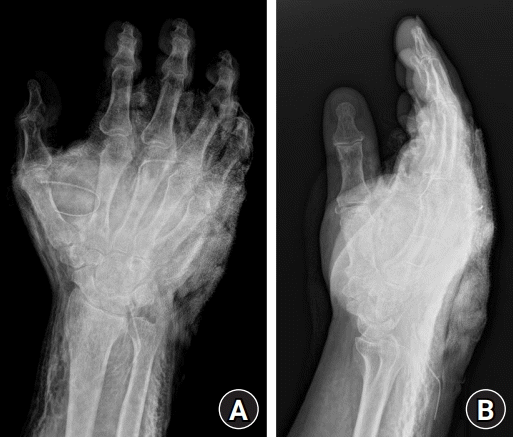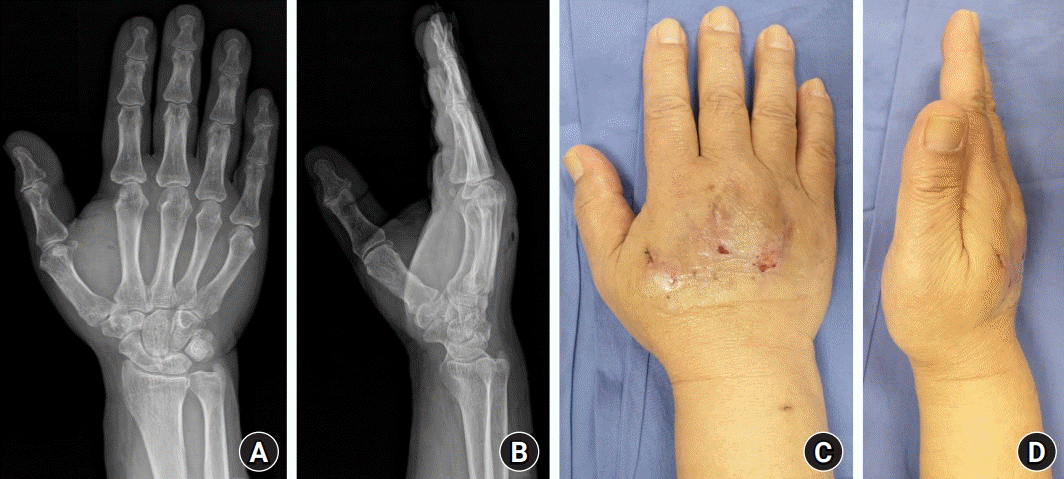Abstract
There are no treatment guidelines for the extravasation of contrast medium. A 71-year-old man underwent coronary artery computed tomography. When contrast medium (iohexol) was injected through the right cephalic vein, massive leakage into the surrounding tissues occurred. A physical examination showed severe swelling of the hand and a prolonged capillary refill time. X-rays showed a massive accumulation of contrast medium in the hand. We immediately performed surgical treatment, including four skin incisions on the hand, subcutaneous dissection, and squeezing, which led to the removal of 50 mL of liquid. The immediate postoperative radiographic findings showed dramatic fading of most of the contrast medium. Four days postoperatively, radiography showed complete dissolution of all contrast medium, and a physical examination revealed full recovery of skin color and capillary refill time. We successfully managed massive extravasation of contrast medium in the hand with immediate surgical treatment. An immediate surgical approach for massive extravasation should be considered to achieve favorable outcomes.
Extravasation is the injection of a drug that leaks out of the vessel. Extravasation can cause serious complications, such as compartment syndrome; therefore, adequate treatment is required, but no treatment has been established [1]. By presenting this case, we hope to advance extravasation treatment.
The study protocol and research procedures complied with the ethical guidelines of the 1975 Declaration of Helsinki. The Institutional Review Board of Kangbuk Samsung Hospital approved this study (No. 2022-11-028). Written consent was obtained from all patients for information and images from online open-access publications before performing treatment procedures and surgeries.
A 71-year-old male took a coronary artery computed tomography (CT) with contrast medium. A massive leakage occurred when injecting the contrast media (iohexol, 80 mg; Omnipaque, GE Healthcare, Chicago, IL, USA) through the right cephalic vein using the infusion pump. The patient immediately experienced pain and swelling occurred. The patient visited the emergency room and X-rays showed massive accumulation of contrast media in the subcutaneous layer from the left forearm to the hand (Fig. 1). The patient’s pain was rated on the Numeric Rating Scale (NRS) as 7 points. The distal sensory function at the second finger decreased by 70% compared to the contralateral side, and the motor power of hand flexion was grade 3. The capillary refill time (CRT) was 5 seconds, suggesting poor peripheral circulation. The plastic surgeon made three incisions on the dorsal side of the hand and one incision in the distal forearm and approximately 20 mL of liquid was discharged when manually squeezing. However, the hand swelling persisted. Therefore, surgical dissection using iris scissors was performed at the subcutaneous plane. When inserting the suction catheter through the incision sites, about 30 mL of contrast medium was discharged. The pain was reduced to NRS 3 points. The motor power of the hand grip recovered to grade 4. The CRT was 3 seconds, suggesting that the blood circulation returned to normal. Immediate postoperative X-rays showed dramatically faded contrast media with decreased swelling (Fig. 2). We inserted silicone drains into the incision sites. On postoperative day 4, there was no swelling at all, and the pain was NRS 0 points. The sensation had fully recovered, and motor power was grade 5. We removed the silicone drain and sutured the incision sites. The suture was stitched out on postoperative day 10, and the wound healed without visible scarring (Fig. 3).
With the spread of CT devices, extravasation with contrast media is rapidly increasing [1]. Extravasation occurs when using an infusion pump and is reported to occur in 0.1% to 0.9% of patients who undergo contrast enhancement CT [2]. When using an infusion pump, the injection pressure is maintained even if extravasation occurs [3]. According to recent reports, it is anticipated that the smaller the diameter of the catheter, the higher the possibility of extravasation since patients with poor vascular conditions use catheters with a smaller diameter [4]. Even if extravasation of contrast media occurs, most patients have only mild symptoms, such as swelling and tenderness. However, skin necrosis and compartment syndrome may occur, and surgical treatment may be required [5]. It has been reported that the higher the volume of leaked contrast media, the increased likelihood that severe complications occur [6]. Peripheral blood vessel issues such as atherosclerosis and venous thrombosis have been reported to be associated with severe complications such as compartment syndrome [7]. Treatment of extravasation includes conservative management, such as wound area elevation and compression treatments; invasive treatment includes aspiration or suction of contrast media using tubes and drainage [5]. Surgical treatment should immediately be considered when swelling and pain worsen after 2 to 4 hours of extravasation [2]. When surgical drainage is performed, radiography should be performed to ensure the complete removal of the contrast medium. Vandeweyer et al. [8] reported that emergency aspiration and isotonic sodium chloride solution washing within 2 hours are effective treatments. In this case, despite severe swelling, there were no severe complications, such as compartment syndrome. The difference from the previous case reports is that surgical treatment was performed immediately without waiting for the absorption of contrast media. To prevent the extravasation of contrast media, the education of patients and medical staff is important, and immediate and appropriate treatment will be helpful when extravasation occurs.
References
1. Kaller MO, An J. Contrast Agent Toxicity [updated 2022 May 26]. In: StatPearls [Internet]. Treasure Island, FL: StatPearls Publishing;2022. Available from: https://www.ncbi.nlm.nih.gov/books/NBK537159/.
2. American College of Radiology. ACR Manual on contrast media. 10th ed. Reston, VA: American College of Radiology;2017. p. 20–3.
3. Federle MP, Chang PJ, Confer S, Ozgun B. Frequency and effects of extravasation of ionic and nonionic CT contrast media during rapid bolus injection. Radiology. 1998; 206:637–40.
4. Heshmatzadeh Behzadi A, Farooq Z, Newhouse JH, Prince MR. MRI and CT contrast media extravasation: a systematic review. Medicine (Baltimore). 2018; 97:e0055.
5. Bellin MF, Jakobsen JA, Tomassin I, et al. Contrast medium extravasation injury: guidelines for prevention and management. Eur Radiol. 2002; 12:2807–12.
6. Wang CL, Cohan RH, Ellis JH, Adusumilli S, Dunnick NR. Frequency, management, and outcome of extravasation of nonionic iodinated contrast medium in 69,657 intravenous injections. Radiology. 2007; 243:80–7.
7. Hadaway L. Infiltration and extravasation. Am J Nurs. 2007; 107:64–72.
8. Vandeweyer E, Heymans O, Deraemaecker R. Extravasation injuries and emergency suction as treatment. Plast Reconstr Surg. 2000; 105:109–10.
Fig. 1.
Preoperative images at 1 hour after extravasation. (A, B) Preoperative X-ray shows severe swelling and marked contrast enhancement. (C, D) Preoperative image of purple discoloration on the dorsal side of the hand, indicating decreased circulation.





 PDF
PDF Citation
Citation Print
Print





 XML Download
XML Download